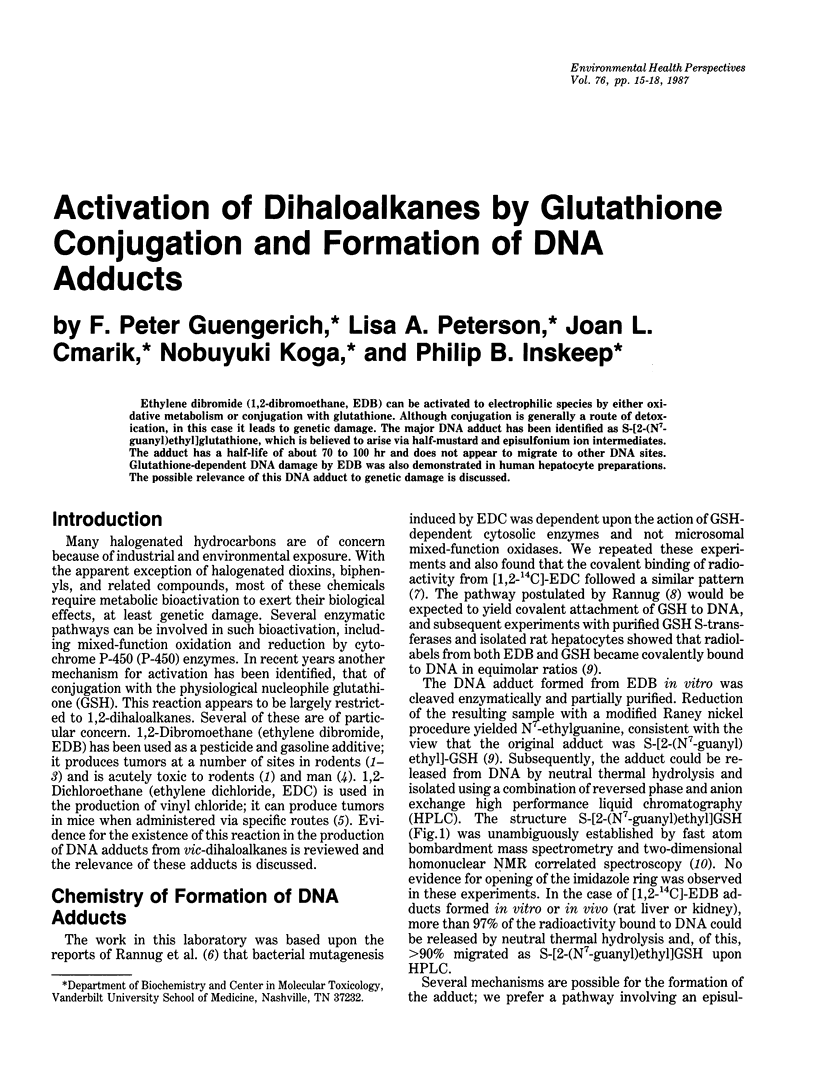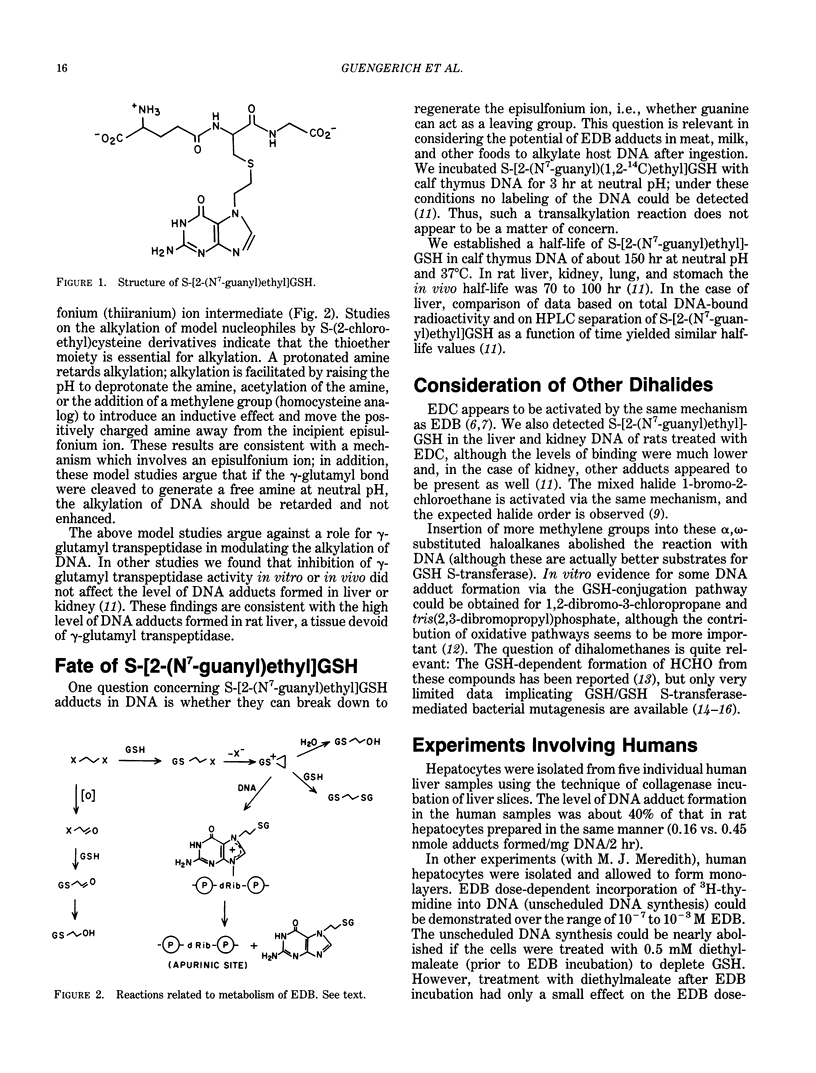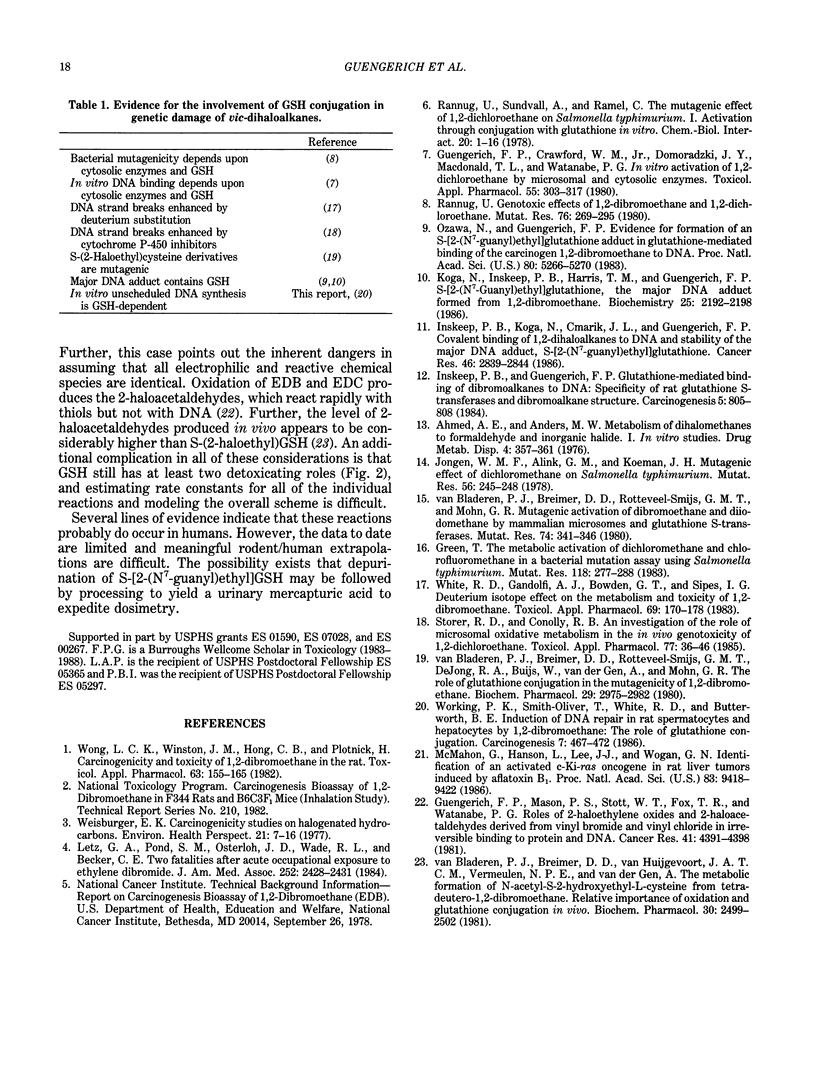Abstract
Ethylene dibromide (1,2-dibromoethane, EDB) can be activated to electrophilic species by either oxidative metabolism or conjugation with glutathione. Although conjugation is generally a route of detoxication, in this case it leads to genetic damage. The major DNA adduct has been identified as S-[2-(N7-guanyl)ethyl]glutathione, which is believed to arise via half-mustard and episulfonium ion intermediates. The adduct has a half-life of about 70 to 100 hr and does not appear to migrate to other DNA sites. Glutathione-dependent DNA damage by EDB was also demonstrated in human hepatocyte preparations. The possible relevance of this DNA adduct to genetic damage is discussed.
Full text
PDF



Images in this article
Selected References
These references are in PubMed. This may not be the complete list of references from this article.
- Ahmed A. E., Anders M. W. Metabolism of dihalomethanes to formaldehyde and inorganic halide. I. In vitro studies. Drug Metab Dispos. 1976 Jul-Aug;4(4):357–361. [PubMed] [Google Scholar]
- Green T. The metabolic activation of dichloromethane and chlorofluoromethane in a bacterial mutation assay using Salmonella typhimurium. Mutat Res. 1983 Sep;118(4):277–288. doi: 10.1016/0165-1218(83)90211-2. [DOI] [PubMed] [Google Scholar]
- Guengerich F. P., Crawford W. M., Jr, Domoradzki J. Y., Macdonald T. L., Watanabe P. G. In vitro activation of 1,2-dichloroethane by microsomal and cytosolic enzymes. Toxicol Appl Pharmacol. 1980 Sep 15;55(2):303–317. doi: 10.1016/0041-008x(80)90092-7. [DOI] [PubMed] [Google Scholar]
- Guengerich F. P., Mason P. S., Stott W. T., Fox T. R., Watanabe P. G. Roles of 2-haloethylene oxides and 2-haloacetaldehydes derived from vinyl bromide and vinyl chloride in irreversible binding to protein and DNA. Cancer Res. 1981 Nov;41(11 Pt 1):4391–4398. [PubMed] [Google Scholar]
- Inskeep P. B., Guengerich F. P. Glutathione-mediated binding of dibromoalkanes to DNA: specificity of rat glutathione-S-transferases and dibromoalkane structure. Carcinogenesis. 1984 Jun;5(6):805–808. doi: 10.1093/carcin/5.6.805. [DOI] [PubMed] [Google Scholar]
- Inskeep P. B., Koga N., Cmarik J. L., Guengerich F. P. Covalent binding of 1,2-dihaloalkanes to DNA and stability of the major DNA adduct, S-[2-(N7-guanyl)ethyl]glutathione. Cancer Res. 1986 Jun;46(6):2839–2844. [PubMed] [Google Scholar]
- Jongen W. M., Alink G. M., Koeman J. H. Mutagenic effect of dichloromethane on Salmonella typhimurium. Mutat Res. 1978 Jan;56(3):245–248. doi: 10.1016/0027-5107(78)90191-4. [DOI] [PubMed] [Google Scholar]
- Koga N., Inskeep P. B., Harris T. M., Guengerich F. P. S-[2-(N7-guanyl)ethyl]glutathione, the major DNA adduct formed from 1,2-dibromoethane. Biochemistry. 1986 Apr 22;25(8):2192–2198. doi: 10.1021/bi00356a051. [DOI] [PubMed] [Google Scholar]
- Letz G. A., Pond S. M., Osterloh J. D., Wade R. L., Becker C. E. Two fatalities after acute occupational exposure to ethylene dibromide. JAMA. 1984 Nov 2;252(17):2428–2431. [PubMed] [Google Scholar]
- McMahon G., Hanson L., Lee J. J., Wogan G. N. Identification of an activated c-Ki-ras oncogene in rat liver tumors induced by aflatoxin B1. Proc Natl Acad Sci U S A. 1986 Dec;83(24):9418–9422. doi: 10.1073/pnas.83.24.9418. [DOI] [PMC free article] [PubMed] [Google Scholar]
- Ozawa N., Guengerich F. P. Evidence for formation of an S-[2-(N7-guanyl)ethyl]glutathione adduct in glutathione-mediated binding of the carcinogen 1,2-dibromoethane to DNA. Proc Natl Acad Sci U S A. 1983 Sep;80(17):5266–5270. doi: 10.1073/pnas.80.17.5266. [DOI] [PMC free article] [PubMed] [Google Scholar]
- Rannug U. Genotoxic effects of 1,2-dibromoethane and 1,2-dichloroethane. Mutat Res. 1980 Nov;76(3):269–295. doi: 10.1016/0165-1110(80)90020-2. [DOI] [PubMed] [Google Scholar]
- Storer R. D., Conolly R. B. An investigation of the role of microsomal oxidative metabolism in the in vivo genotoxicity of 1,2-dichloroethane. Toxicol Appl Pharmacol. 1985 Jan;77(1):36–46. doi: 10.1016/0041-008x(85)90265-0. [DOI] [PubMed] [Google Scholar]
- Weisburger E. K. Carcinogenicity studies on halogenated hydrocarbons. Environ Health Perspect. 1977 Dec;21:7–16. doi: 10.1289/ehp.77217. [DOI] [PMC free article] [PubMed] [Google Scholar]
- White R. D., Gandolfi A. J., Bowden G. T., Sipes I. G. Deuterium isotope effect on the metabolism and toxicity of 1,2-dibromoethane. Toxicol Appl Pharmacol. 1983 Jun 30;69(2):170–178. doi: 10.1016/0041-008x(83)90297-1. [DOI] [PubMed] [Google Scholar]
- Wong L. C., Winston J. M., Hong C. B., Plotnick H. Carcinogenicity and toxicity of 1,2-dibromoethane in the rat. Toxicol Appl Pharmacol. 1982 Apr;63(2):155–165. doi: 10.1016/0041-008x(82)90036-9. [DOI] [PubMed] [Google Scholar]
- Working P. K., Smith-Oliver T., White R. D., Butterworth B. E. Induction of DNA repair in rat spermatocytes and hepatocytes by 1,2-dibromoethane: the role of glutathione conjugation. Carcinogenesis. 1986 Mar;7(3):467–472. doi: 10.1093/carcin/7.3.467. [DOI] [PubMed] [Google Scholar]
- van Bladeren P. J., Breimer D. D., Rotteveel-Smijs G. M., Mohn G. R. Mutagenic activation of dibromomethane and diiodomethane by mammalian microsomes and glutathione S-transferases. Mutat Res. 1980 Oct;74(5):341–346. doi: 10.1016/0165-1161(80)90192-2. [DOI] [PubMed] [Google Scholar]
- van Bladeren P. J., Breimer D. D., Rotteveel-Smijs G. M., de Jong R. A., Buijs W., van der Gen A., Mohn G. R. The role of glutathione conjugation in the mutagenicity of 1,2-dibromoethane. Biochem Pharmacol. 1980 Nov 1;29(21):2975–2982. doi: 10.1016/0006-2952(80)90047-7. [DOI] [PubMed] [Google Scholar]



